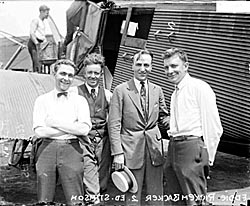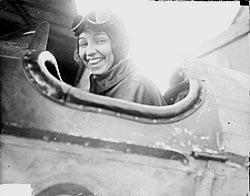
Stinson Field, dating from the latter part of 1915, was San Antonio's first municipal airport. It has remained in operation since that time, being the only airport in San Antonio, Texas, for many years. It was established by the Stinson family of aviation pioneers. Hoping to finance her musical education with money earned from exhibition flying, Alabama native Katherine Stinson (1891-1977) convinced famed flight instructor Max Lillie of Chicago to take her on as a student in 1912. Katherine became the fourth licensed female pilot in the U.S., began touring as a stunt pilot and became one of the country's most famous female aviatiors. Her family--mother Emma, sister Marjorie and brothers Eddie and Jack--established the Stinson Aviation Company in Hot Springs, Arkansas. Marjorie and Eddie trained at the Wright Flying School in Ohio and also became pilots (Marjorie becoming the ninth licensed female pilot in the world). In 1913, Max Lillie encouraged the Stinsons to move to San Antonio where the army had granted him permission to use the parade ground at Fort Sam Houston. According to the San Antonio Express (December 1 and 5, 1915), Marjorie (age 19) and Edward Stinson ran the flying school, utilizing the drill field at Fort Sam Houston, from 1914 to 1915.
Marjorie Stinson petitioned the City Council to lease land for use as an airport. Once approved, the family leased 500 acres of farmland from the city in 1916 and established Stinson Field. Marjorie founded the Stinson School of Aviation, thus being the first woman to own and operate a flying school in the United States. During its first years in operation, the Stinson family flying school trained many World War I pilots. After the ban of civilian flights during World War I, Stinson Field became the city's civil airport in 1918. Charles Lindbergh kept an airplane and flew out of Stinson while he was stationed at Brooks Field.

Stinson Field's name was changed for nine years to "Windburn Field" following the October 15, 1927, airplane crash of reporter, Bill Windburn. It was into Windburn Field that the first scheduled airmail flight in San Antonio arrived on February 6, 1928. In the 1930s, commercial airlines began using the airport and construction of a new terminal building with Works Progress Administration funds enhanced the facility. On July 15, 1936, the airfield was renamed Stinson Field in commemoration of its original founders. During World War II it once again became an Army Air Corps training facility. Returned to civilian use after the war, Stinson Field became the primary general aviation airport for the city of San Antonio. Part of Stinson Field was utilized by the National Guard for a couple of years, accounting for the barracks still present on the southwestern portion of the field. Although the San Antonio International Airport is the primary airport in the San Antonio area today, Stinson Field has remained an important commercial and recreational air center.
Visit the National Park Service Travel American Aviation to learn more about Aviation related Historic Sites.
Last updated: September 3, 2017
